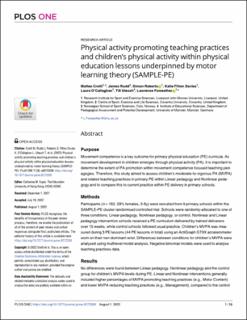| dc.contributor.author | Crotti, Matteo | |
| dc.contributor.author | Rudd, James Robert | |
| dc.contributor.author | Roberts, Simon | |
| dc.contributor.author | O’Callaghan, Laura | |
| dc.contributor.author | Utesch, Till | |
| dc.contributor.author | Foweather, Lawrence | |
| dc.contributor.author | Davies, Katie Fitton | |
| dc.date.accessioned | 2022-12-01T12:32:32Z | |
| dc.date.available | 2022-12-01T12:32:32Z | |
| dc.date.created | 2022-10-19T08:14:50Z | |
| dc.date.issued | 2022 | |
| dc.identifier.citation | PLoS ONE. 2022, 17(8), Artikkel e0272339. | en_US |
| dc.identifier.issn | 1932-6203 | |
| dc.identifier.uri | https://hdl.handle.net/11250/3035358 | |
| dc.description | This is an open access article distributed under the terms of the Creative Commons Attribution License, which permits unrestricted use, distribution, and reproduction in any medium, provided the original author and source are credited. | en_US |
| dc.description.abstract | Purpose: Movement competence is a key outcome for primary physical education (PE) curricula. As movement development in children emerges through physical activity (PA), it is important to determine the extent of PA promotion within movement competence focused teaching pedagogies. Therefore, this study aimed to assess children’s moderate-to-vigorous PA (MVPA) and related teaching practices in primary PE within Linear pedagogy and Nonlinear pedagogy and to compare this to current practice within PE delivery in primary schools.
Methods: Participants (n = 162, 53% females, 5-6y) were recruited from 9 primary schools within the SAMPLE-PE cluster randomised controlled trial. Schools were randomly-allocated to one of three conditions: Linear pedagogy, Nonlinear pedagogy, or control. Nonlinear and Linear pedagogy intervention schools received a PE curriculum delivered by trained deliverers over 15 weeks, while control schools followed usual practice. Children’s MVPA was measured during 3 PE lessons (44 PE lessons in total) using an ActiGraph GT9X accelerometer worn on their non-dominant wrist. Differences between conditions for children’s MVPA were analysed using multilevel model analysis. Negative binomial models were used to analyse teaching practices data.
Results: No differences were found between Linear pedagogy, Nonlinear pedagogy and the control group for children’s MVPA levels during PE. Linear and Nonlinear interventions generally included higher percentages of MVPA promoting teaching practices (e.g., Motor Content) and lower MVPA reducing teaching practices (e.g., Management), compared to the control group. Teaching practices observed in Linear and Nonlinear interventions were in line with the respective pedagogical principles.
Conclusions: Linear and Nonlinear pedagogical approaches in PE do not negatively impact MVPA compared to usual practice. Nevertheless, practitioners may need to refine these pedagogical approaches to improve MVPA alongside movement competence. | en_US |
| dc.language.iso | eng | en_US |
| dc.subject | children | en_US |
| dc.subject | exercise | en_US |
| dc.subject | human learning | en_US |
| dc.subject | pedagogy | en_US |
| dc.subject | physical activity | en_US |
| dc.subject | schools | en_US |
| dc.subject | sports | en_US |
| dc.subject | teachers | en_US |
| dc.title | Physical activity promoting teaching practices and children’s physical activity within physical education lessons underpinned by motor learning theory (SAMPLE-PE) | en_US |
| dc.type | Peer reviewed | en_US |
| dc.type | Journal article | en_US |
| dc.description.version | publishedVersion | en_US |
| dc.rights.holder | © 2022 Crotti et al. | en_US |
| dc.source.pagenumber | 26 | en_US |
| dc.source.volume | 17 | en_US |
| dc.source.journal | PLoS ONE | en_US |
| dc.source.issue | 8 | en_US |
| dc.identifier.doi | 10.1371/journal.pone.0272339 | |
| dc.identifier.cristin | 2062566 | |
| dc.description.localcode | Institutt for lærerutdanning og friluftslivsstudier / Department of Teacher Education and Outdoor Studies | en_US |
| dc.source.articlenumber | e0272339 | en_US |
| cristin.ispublished | true | |
| cristin.fulltext | original | |
| cristin.qualitycode | 1 | |
